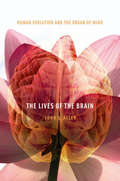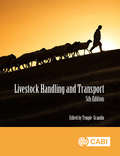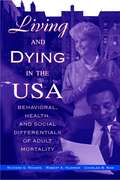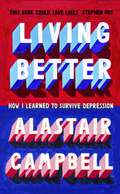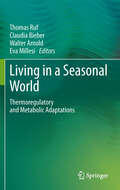- Table View
- List View
Liver Transplantation and Hepatobiliary Surgery: Interplay of Technical and Theoretical Aspects (Updates in Surgery)
by Umberto Cillo Luciano De CarlisIn the past, liver resections and liver transplantations were performed by different surgical teams, with very little interplay between the two. However, the evolution toward more complex operations called for an increasingly intense interaction between these surgical techniques: split liver and living donor liver transplantation have become popular in the transplant community, utilizing the Coinaud segmental anatomy in a very sophisticated way, while portal and arterial resection and reconstruction have become indispensable methods for treating Klatskin tumors infiltrating the hepatic hilum. This book offers a complete overview of the connections between liver transplantation and hepatobiliary surgery. It focuses on ex situ techniques for resection of tumors at the suprahepatic confluence, with or without venous reconstruction, and on total vascular exclusion of the liver with the aid of a venovenous bypass that should be a surgical option for referral centers in hepatopancreatobiliary surgery. By taking into consideration the development of minimally invasive liver surgery, it will introduce readers to a variety of new perspectives such as: vascular exclusion techniques with or without extracorporeal circulation, hemodynamic implications and lessons learned from liver transplant surgery, and technical details on pediatric transplantation and its informative role in modern biliary tract surgery.
Liver (UEB contracted)
by RnibThis is a two-page document with diagrams of the human digestive system and the liver. The diagrams are labelled with numbers and may be used for testing purposes. There is a locator dot shown, which will be at the top left of the page when the image is the correct way up. The diagram of the digestive system shows the mouth at the top of the image and the anus at the bottom centre of the page. The diagram of the liver shows the liver in the top left and centre of the image with the gall bladder to the left. The bile duct is shown in the centre of the image. The pancreas goes from the bottom centre of the image to the centre right.
Liver Ultrasound: From Basics to Advanced Applications
by Adrian K.P. Lim Matteo RosselliLiver Ultrasound An up-to-date discussion of modern liver ultrasound techniques, combining hepatological and radiological perspectives into one stand-alone resource. In Liver Ultrasound: From Basics to Advanced Applications, a team of distinguished experts delivers an in-depth textbook on how to perform liver ultrasound and interpret common and uncommon clinical findings. The authors also walk readers through the nuances of ultrasonic and parametric features, from both a radiological and hepatological perspective, in differentiating the multitude of liver conditions. They also discuss clinical evaluations and how to use more advanced and currently evolving techniques. Readers will experience well-illustrated and clear ultrasound images while also getting access to a complimentary website that features numerous videos which integrate the book’s modern and multidisciplinary approach. The book also includes: A thorough introduction to the basics of ultrasound, as well as ultrasound scanners and knobology Comprehensive explanations on how to perform a liver ultrasound, including routine practicalities, discussions of normal liver anatomy, normal variants and advanced Doppler techniques Practical discussions of focal liver lesions, including their characterization and detection and how contrast enhanced ultrasound plays a pivotal role A clinical overview on the use of point of care ultrasound in liver disease as well as the use of ultrasound in liver related infectious diseases, biliary disorders and pediatric liver disease An extensive overview on the use of ultrasound and specific findings in liver transplantation The role of ultrasound in chronic liver disease, vascular liver diseases and interventional procedures, as well as discussions on advancing technologies namely shearwave elastography, attenuation imaging and fusion Perfect for all who perform liver sonography namely, hepatologists, radiologists, internal and emergency medicine physicians and sonographers. Liver Ultrasound: From Basics to Advanced Applications will also benefit trainees from all these specialties.
Liver Ultrasound: From Basics to Advanced Applications
by Adrian Lim Matteo RosselliLiver Ultrasound An up-to-date discussion of modern liver ultrasound techniques, combining hepatological and radiological perspectives into one stand-alone resource. In Liver Ultrasound: From Basics to Advanced Applications, a team of distinguished experts delivers an in-depth textbook on how to perform liver ultrasound and interpret common and uncommon clinical findings. The authors also walk readers through the nuances of ultrasonic and parametric features, from both a radiological and hepatological perspective, in differentiating the multitude of liver conditions. They also discuss clinical evaluations and how to use more advanced and currently evolving techniques. Readers will experience well-illustrated and clear ultrasound images while also getting access to a complimentary website that features numerous videos which integrate the book’s modern and multidisciplinary approach. The book also includes: A thorough introduction to the basics of ultrasound, as well as ultrasound scanners and knobology Comprehensive explanations on how to perform a liver ultrasound, including routine practicalities, discussions of normal liver anatomy, normal variants and advanced Doppler techniques Practical discussions of focal liver lesions, including their characterization and detection and how contrast enhanced ultrasound plays a pivotal role A clinical overview on the use of point of care ultrasound in liver disease as well as the use of ultrasound in liver related infectious diseases, biliary disorders and pediatric liver disease An extensive overview on the use of ultrasound and specific findings in liver transplantation The role of ultrasound in chronic liver disease, vascular liver diseases and interventional procedures, as well as discussions on advancing technologies namely shearwave elastography, attenuation imaging and fusion Perfect for all who perform liver sonography namely, hepatologists, radiologists, internal and emergency medicine physicians and sonographers. Liver Ultrasound: From Basics to Advanced Applications will also benefit trainees from all these specialties.
The Lives of the Brain: Human Evolution And The Organ Of Mind
by John S. AllenThough we have other distinguishing characteristics (walking on two legs, for instance, and relative hairlessness), the brain and the behavior it produces are what truly set us apart from the other apes and primates. And how this three-pound organ composed of water, fat, and protein turned a mammal species into the dominant animal on earth today is the story John S. Allen seeks to tell.
Livestock Handling and Transport: Principles And Practice
by Adrian Barber Faith Baier Keith Belk Donald Broom Michelle S. Calvo-Lorenzo Michael Cockram Lorna Coppinger Raymond Coppinger Trevor DeVries Roger Ewbank Luigi Faucitano Robert B. Freeman Wendy K Fulwider Carmen Gallo Arlene Garcia-Marquez Peter Goddard Paul Hemsworth Stella Maris Huertas Anna Johnson Katherine A. Houpt Geoffrey D. Hutson Mateus J.R. Costa Miriam Parker Clive Phillips Matthew J. Ritter Karen Schwartzkopf-Genswein Meagan King E. Bert Lambooij Genaro C. Lama Pol Llonch Obiols Edmond A. Pajor Emma Fabreger Romans Frank Tuyttens Antonio Velarde Kurt Vogel Claire A Weeks Carissa L. WickensEdited by world-renowned animal scientist Dr Temple Grandin, this practical book integrates scientific research and industry literature on cattle, pigs, poultry, sheep, goats, deer, and horses, in both the developed and developing world, to provide a practical guide to humane handling and minimizing animal stress. Reviewing the latest research on transport systems, restraint methods and facilities for farms and slaughterhouses, this fully updated fifth edition of Livestock Handling and Transport includes five new chapters: The Introduction, Genetics and Handling, Goat Handling and Transport, Robotic Milking, and Transport of Livestock by Sea. There is also new coverage of temperament testing and change, the principles of good stockmanship as well as including new video material to further explain key information contained in the book. Key features include: - Edited by world-renowned animal scientist Temple Grandin. - Two new chapters on the testing and control of temperament and the principles of good stockmanship. - Online videos to further illustrate the key points.
Livestock Ration Formulation for Dairy Cattle and Buffalo
by Ravinder Singh Kuntal Radha Gupta D. Rajendran Vishal PatilLivestock Ration Formulation for Dairy Cattle and Buffalo provides an interdisciplinary, integrative perspective and optimization on dairy cattle feed formulation problem solving. It helps dairy farmers by introducing them the right frequency and right amount of balanced diet to be fed to cattle’s and buffaloes at different body condition so that their feeding cost should be decreased and there should be increase in income for dairy farmers, as they don’t have enough knowledge of feeding practice. It helps animal nutritionist to work for dairy farmers which have very limited feed resources to fulfil nutrients requirement in terms of crude protein (CP), total digestible nutrient (TDN), calcium (Ca) and phosphorus (P) by developing a software programme to plan a balanced low budget diet. It includes the Linear and Goal programming model for non-pregnant dairy buffalo is been solved using Hybrid Real Coded Genetic Algorithm and the results are compared with Real Coded Genetic Algorithm (RGA) considering different versions like RGA without crossover, RGA without Mutation, RGA with crossover and mutation. These models can also be applied with other nutritional models like CNCPS, INRA. This book is a step forward in that direction to provide least cost diet formulation based on nutrient requirement of the cattle and buffalo, which is been calculated according to Indian Council of Agricultural Research (ICAR, 2013) and NRC (2001) on dry matter basis, provides a clear and precise platform for other researcher in Animal Nutrition field which also give initial platform to build a software and android application to formulate least cost ration Based on data and algorithm used in this book, which helps Dairy farmers directly to feed balanced diet at cheap rate. Features: It is a good reference to local dairy farmers by introducing them to the right frequency and right amount of balanced diet to be fed to cattle and buffaloes at different production cycles. It will provide basic platform and some solutions to built-up software about cattle nutrition development and least cost formulation for end-user. It has several techniques for optimizing animal diet formulation but a good balance between coding/programming and animal nutrition is incorporated towards application of soft computing technique to improve the quality of the solution due to rigidity of the constraints.
Livestock Ration Formulation for Dairy Cattle and Buffalo
by Ravinder Singh Kuntal Radha Gupta D. Rajendran Vishal PatilLivestock Ration Formulation for Dairy Cattle and Buffalo provides an interdisciplinary, integrative perspective and optimization on dairy cattle feed formulation problem solving. It helps dairy farmers by introducing them the right frequency and right amount of balanced diet to be fed to cattle’s and buffaloes at different body condition so that their feeding cost should be decreased and there should be increase in income for dairy farmers, as they don’t have enough knowledge of feeding practice. It helps animal nutritionist to work for dairy farmers which have very limited feed resources to fulfil nutrients requirement in terms of crude protein (CP), total digestible nutrient (TDN), calcium (Ca) and phosphorus (P) by developing a software programme to plan a balanced low budget diet. It includes the Linear and Goal programming model for non-pregnant dairy buffalo is been solved using Hybrid Real Coded Genetic Algorithm and the results are compared with Real Coded Genetic Algorithm (RGA) considering different versions like RGA without crossover, RGA without Mutation, RGA with crossover and mutation. These models can also be applied with other nutritional models like CNCPS, INRA. This book is a step forward in that direction to provide least cost diet formulation based on nutrient requirement of the cattle and buffalo, which is been calculated according to Indian Council of Agricultural Research (ICAR, 2013) and NRC (2001) on dry matter basis, provides a clear and precise platform for other researcher in Animal Nutrition field which also give initial platform to build a software and android application to formulate least cost ration Based on data and algorithm used in this book, which helps Dairy farmers directly to feed balanced diet at cheap rate. Features: It is a good reference to local dairy farmers by introducing them to the right frequency and right amount of balanced diet to be fed to cattle and buffaloes at different production cycles. It will provide basic platform and some solutions to built-up software about cattle nutrition development and least cost formulation for end-user. It has several techniques for optimizing animal diet formulation but a good balance between coding/programming and animal nutrition is incorporated towards application of soft computing technique to improve the quality of the solution due to rigidity of the constraints.
Livid: The new Kay Scarpetta thriller from the No.1 bestseller (Kay Scarpetta #26)
by Patricia CornwellTHE THRILLING NEW KAY SCARPETTA MYSTERY FROM THE #1 GLOBAL BESTSELLERMurder and mayhem. Scarpetta is back, and she's racing against the clock . . .Chief medical examiner Kay Scarpetta is the reluctant star witness in a sensational murder trial when she receives shocking news. The judge's sister has been found dead. At first glance, it appears to be a home invasion, but then why was nothing stolen, and why is the garden strewn with dead plants and insects?Although there is no apparent cause of death, Scarpetta recognizes tell-tale signs of the unthinkable, and she knows the worst is yet to come. The forensic pathologist finds herself pitted against a powerful force that returns her to the past, and her time to catch the killer is running out . . .'RIVETING' THE TIMES'CORNWELL KNOWS HOW TO CRAFT A MEAN PAGE-TURNER AND LIVID IS NO EXCEPTION' TELEGRAPH'ONE OF THE BEST CRIME WRITERS WRITING TODAY' GUARDIAN'ASTONISHING . . . THIRTY YEARS ON, THERE'S STILL NO OTHER CRIME WRITER LIKE HER' SUNDAY TIMES
Living Allergy Free: How to Create and Maintain an Allergen- and Irritant-Free Environment
by Edwin L. Klingelhofer M. Eric GershwinIn this commonsense book, Dr. Gershwin and Dr. Klingelhofer offer sensible, practical strategies for identifying the substances that cause allergies (allergens), the symptoms they cause, ways exposure to allergens can be avoided or reduced, and ways you can relieve the symptoms. Living Allergy Free also treats some reactions that are commonly assumed to be allergies, but are really sensitivity or irritant reactions, shows how they can be distinguished from true allergies, and tells you what to do about them. If you suffer from allergies-or if you think you do-Living Allergy Free is just what the doctor would order!
Living and Dying in the USA: Behavioral, Health, and Social Differentials of Adult Mortality
by Richard G. Rogers Robert A. Hummer Charles B. NamThe simplicity of using one data set in addressing the relationship of single variables to mortality distinguishes Living and Dying in the USA from other recent investigations of mortality. The authors use the recently released National Health Interview Survey and the National Death Index to make a definitive statement about demographics and mortality. By surveying demographic and sociocultural characteristics associated with mortality, socioeconomic effects, health-related conditions, and health status, they reveal connections among several factors related to mortality chances. Easily understood and cited, their study emphasizes the statistical methods underlying their revelations and invites readers to duplicate their results.Comprehensive coverage of US adult mortality differentialsBased on a new and innovative data setIncludes factors rarely examined in related mortality researchNot only documents mortality differentials, but explores explanations for themExtensive list of references associated with each chapterConsistent, straightforward methodology used throughout aids readers in both understanding the content and in comparing results from chapter to chapter
Living and Dying Well (Critical Issues in Social Justice)
by Lewis PetrinovichLiving and Dying Well takes an informed, interdisciplinary approach to the problems, data, theory, and procedures that a just society must consider when establishing policies regarding human life and death. Leading psychologist Lewis Petrinovich expands on the controversial arguments developed in his earlier work, Human Evolution, Reproduction, and Morality, and considers such contemporary issues as: the morality of human genetic screening and of the Human Genome Project; organ transplants; the allowance of suicide and euthanasia; and physicians assisting in the dying process.
Living and Dying with AIDS
by NancyAhmed Paul I. AhmedIn this nation, in this decade, there is only one way to deal with an individual who is sick-with dignity, with compassion, care and confidentiality, and without discrimi nation. Statement made by President George Bush at the National Business Leadership Conference This book is about the care of sick human beings. It is about the heroic struggle of individuals with AIDS. It is about their daily coping in the workplace and at home; about economic problems, the loss of friendship and family support, and physical and emotional pain. But it is also about empowering them to deal with their disease, viewing them not as victims but as warriors, vital and active par ticipants in their battle against AIDS. This book is also about the social context in which HIV-infected persons and people with AIDS live. It is about how we must learn to deal with sickness in more compassionate and humanitarian ways and what we yet need to learn. It touches on the health care system that confronts those who are ill, on programs of prevention and education, and on the personal implications of broader national and local policies.
Living Better: How I Learned to Survive Depression
by Alastair CampbellLast Christmas I almost killed myself. Almost. I've had a lot of almosts. Never gone from almost to deed. Don't think I ever will. But it was a bad almost. Living Better is Alastair Campbell's honest, moving and life affirming account of his lifelong struggle with depression. It is an autobiographical, psychological and psychiatric study, which explores his own childhood, family and other relationships, and examines the impact of his professional and political life on himself and those around him. But it also lays bare his relentless quest to understand depression not just through his own life but through different treatments. Every bit as direct and driven, clever and candid as he is, this is a book filled with pain, but also hope -- he examines how his successes have been in part because of rather than despite his mental health problems -- and love. We all know someone with depression. There is barely a family untouched by it. We may be talking about it more than we did, back in the era of 'boys don't cry' - they did you know - and when a brave face or a stiff upper lip or a best foot forward was seen as the only way to go. But we still don't talk about it enough. There is still stigma, and shame, and taboo. There is still the feeling that admitting to being sad or anxious makes us weak. It took me years, decades even to get to this point, but I passionately believe that the reverse is true and that speaking honestly about our feelings and experiences (whether as a depressive or as the friend or relative of a depressive) is the first and best step on the road to recovery. So that is what I have tried to do here.
Living Better with Dementia: Good Practice and Innovation for the Future
by Shibley RahmanWith currently evolving dementia policy, how can we ensure that living well with dementia continues to be a primary aim for future national dementia strategies? This book looks at current policy and research to determine emerging challenges, and what they mean for practice, both nationally and within a global context.
The Living Brain and Alzheimer’s Disease (Research and Perspectives in Alzheimer's Disease)
by YvesChristen Jean-FrançoisDemonet Bradley T. HymanFrom large cross-sectional studies of autopsy material, it seems as if a time course of Alzheimer's Disease, at least on average, can be mapped out: a pattern of hierarchical vulnerability for neuronal loss and neurofibrillary tangles beginning in medial temporal lobe structures proceeding through association areas. Plaques follow their own temporal course, with widespread cortical deposits occurring even early in a disease process. The whole process may well take twenty years, the first half of which may be without overt symptoms.
Living Data: Making Sense of Health Bio-Sensing
by Maggie Mort Celia RobertsAs individuals increasingly seek ways of accessing, understanding and sharing data about their own bodies, this book offers a critique of the popular claim that ‘more information’ equates to ‘better health’. In a study that redefines the public, academic and policy related debates around health, bodies, information and data, the authors consider the ways in which the phenomenon of self-diagnosis has created alternative worlds of knowledge and practises which are often at odds with professional medical advice. With a focus on data that concerns significant life changes, this book explores the potential challenges related to people’s changing relationships with traditional health systems as access to, and control over data shifts.
Living Data: Making Sense of Health Bio-Sensing
by Maggie Mort Celia RobertsAs individuals increasingly seek ways of accessing, understanding and sharing data about their own bodies, this book offers a critique of the popular claim that ‘more information’ equates to ‘better health’. In a study that redefines the public, academic and policy related debates around health, bodies, information and data, the authors consider the ways in which the phenomenon of self-diagnosis has created alternative worlds of knowledge and practises which are often at odds with professional medical advice. With a focus on data that concerns significant life changes, this book explores the potential challenges related to people’s changing relationships with traditional health systems as access to, and control over data shifts.
Living Donor Advocacy: An Evolving Role Within Transplantation
by Jennifer SteelThe inadequate supply of organs in the United States and other countries continues to drive the reliance on living donor transplantation. In 2000, representatives of the transplant community convened for a meeting on living donation in an effort to provide guidelines to promote the welfare of living donors. The consensus statement that resulted from this meeting recommended that transplant centers retain an Independent Living Donor Advocate (ILDA) to focus on the best interest of the donor. A decade later, nearly every transplant center in the United States, performing living donor surgeries, has incorporated an ILDA into their living donor screening and/or evaluation process Living Donor Advocate provides an overview of living donation and its risks, ethical challenges and future developments, as well as details about the role a Living Donor Advocate plays in the transplantation process. This book will interest health professionals across various disciplines and patients undergoing transplantation or living donor surgery.
Living Donor Kidney Transplantation: Current Practices, Emerging Trends and Evolving Challenges
by Jonas Wadström Robert GastonLiving donor kidney (LDK) transplantation has become the definitive approach to the treatment of end-stage renal failure, providing a better quality of life and the best opportunity for survival when compared with dialysis or transplantation from a deceased donor. A timely compendium of the modern day practice of LDK transplantation from a group of
Living Donor Transplantation
by Henkie P. Tan Amadeo Marcos Ron ShapiroEdited by leaders at one of the acclaimed transplant institutions in the United States, this reference covers all aspects of living donor solid organ and cellular transplantation in current clinical practice, including the kidney, liver, pancreas, lung, small bowel, islet, and hematopoietic stem cell transplantation. Detailed, engaging, and organ-
Living in a Seasonal World: Thermoregulatory and Metabolic Adaptations
by Thomas Ruf, Claudia Bieber, Walter Arnold and Eva MillesiThis book summarises the newest information on seasonal adaptation in animals. Topics include animal hibernation, daily torpor, thermoregulation, heat production, metabolic depression, biochemical adaptations, neurophysiology and energy balance. The contributors to this book present interdisciplinary research at multiple levels ranging from the molecular to the ecophysiological, as well as evolutionary approaches. The chapters of this book provide original data not published elsewhere, which makes it the most up-to-date, comprehensive source of information on these fields. The book’s subchapters correspond to presentations given at the 14th International Hibernation Symposium in August 2012 in Austria. This is a very successful series of symposia (held every four years since 1959) that attracts leading researchers in the field. Like the past symposia, this meeting – and consequently the book – is aimed not only at hibernation but at covering the full range of animal adaptations to seasonal environments. For the next four years, this book will serve as the cutting-edge reference work for graduate students and scientists active in this field of physiology and ecology..
Living in Death;€™s Shadow: Family Experiences of Terminal Care and Irreplaceable Loss
by Emily K. AbelWhat is it like to live with;¢;‚¬;€?and love;¢;‚¬;€?someone whose death, while delayed, is nevertheless foretold? In Living in Death;€™s Shadow, Emily K. Abel, an expert on the history of death and dying, examines memoirs written between 1965 and 2014 by family members of people who died from chronic disease. In earlier eras, death generally occurred quickly from acute illnesses, but as chronic disease became the major cause of mortality, many people continued to live with terminal diagnoses for months and even years. Illuminating the excruciatingly painful experience of coping with a family member;€™s extended fatal illness, Abel analyzes the political, personal, cultural, and medical dimensions of these struggles.The book focuses on three significant developments that transformed the experiences of those dying and their intimates: the passage of Medicare and Medicaid, the growing use of high-tech treatments at the end of life, and the rise of a movement to humanize the care of dying people. It questions the exalted value placed on acceptance of mortality as well as the notion that it is always better to die at home than in an institution. Ultimately, Living in Death;€™s Shadow emphasizes the need to shift attention from the drama of death to the entire course of a serious chronic disease. The chapters follow a common narrative of life-threatening disease: learning the diagnosis; deciding whether to enroll in a clinical trial; acknowledging or struggling against the limits of medicine; receiving care at home and in a hospital or nursing home; and obtaining palliative and hospice care. Living in Death;€™s Shadow is essential reading for everyone seeking to understand what it means to live with someone suffering from a chronic, fatal condition, including cancer, AIDS, Alzheimer;€™s, and heart disease.
Living in Death;€™s Shadow: Family Experiences of Terminal Care and Irreplaceable Loss
by Emily K. AbelWhat is it like to live with;¢;‚¬;€?and love;¢;‚¬;€?someone whose death, while delayed, is nevertheless foretold? In Living in Death;€™s Shadow, Emily K. Abel, an expert on the history of death and dying, examines memoirs written between 1965 and 2014 by family members of people who died from chronic disease. In earlier eras, death generally occurred quickly from acute illnesses, but as chronic disease became the major cause of mortality, many people continued to live with terminal diagnoses for months and even years. Illuminating the excruciatingly painful experience of coping with a family member;€™s extended fatal illness, Abel analyzes the political, personal, cultural, and medical dimensions of these struggles.The book focuses on three significant developments that transformed the experiences of those dying and their intimates: the passage of Medicare and Medicaid, the growing use of high-tech treatments at the end of life, and the rise of a movement to humanize the care of dying people. It questions the exalted value placed on acceptance of mortality as well as the notion that it is always better to die at home than in an institution. Ultimately, Living in Death;€™s Shadow emphasizes the need to shift attention from the drama of death to the entire course of a serious chronic disease. The chapters follow a common narrative of life-threatening disease: learning the diagnosis; deciding whether to enroll in a clinical trial; acknowledging or struggling against the limits of medicine; receiving care at home and in a hospital or nursing home; and obtaining palliative and hospice care. Living in Death;€™s Shadow is essential reading for everyone seeking to understand what it means to live with someone suffering from a chronic, fatal condition, including cancer, AIDS, Alzheimer;€™s, and heart disease.



